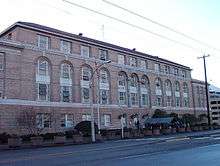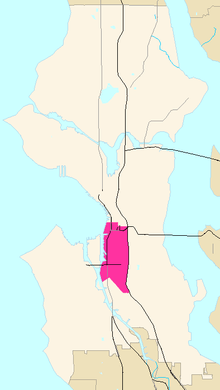Industrial District, Seattle
The Industrial District is the principal industrial area of Seattle, Washington. It is bounded on the west by the Duwamish Waterway and Elliott Bay, beyond which lies Delridge of West Seattle; on the east by Interstate 5, beyond which lies Beacon Hill; on the north by S King and S Dearborn Streets, beyond which lie Pioneer Square and southwest International District of Downtown; and on the south by the main lines of the BNSF Railway and Union Pacific Railroad, or about S Lucille Street, beyond which is Georgetown. SoDo is the name of the northwest portion of the neighborhood, named for its being South of Downtown. SoDo is the location of T-Mobile Park, home of the Seattle Mariners, and CenturyLink Field, home of the Seattle Seahawks and Seattle Sounders FC. CenturyLink Field was also the site of the former Kingdome.


The Industrial District may also be defined by land use, with the primarily residential and open space Delridge district extending west from W Marginal Way SW and south of SW Spokane Street, and with the heavy industrial-zoned lower Duwamish Waterway east of Marginal and north of Spokane as part of the Industrial District.[1]
Most of the Industrial District is built on what was once the mudflats and lowlands of Elliott Bay and the Duwamish estuary, dredged, straightened, and filled 1902 and 1907.[2] Much of the area is also built on landfill which is prone to liquefaction. This makes buildings in this area highly prone to earthquake damage.[3][4]
Principal arterials are First and Fourth Avenues S, Alaskan Way, East Marginal and Airport Ways S (north- and southbound); and S Spokane, the Spokane Street Viaduct, West Seattle Bridge, and S Royal Brougham Way (east- and westbound; Royal Brougham was formerly S Atlantic Street). Minor arterials are 6th Avenue S, S Holgate and S Lander Streets, and S Industrial Way.[5]
History
What is now Seattle has been inhabited since the end of the last glacial period (c. 8,000 BCE—10,000 years ago). For example, the villages of tohl-AHL-too ("herring house") and later hah-AH-poos ("where there are horse clams") at the then-mouth of the Duwamish River in what is now the Industrial District, had been inhabited since the 6th century CE.[6] The Dkhw’Duw’Absh and Xacuabš[7] ("People of the Inside" and "People of the Large Lake", now the Duwamish tribe) of the Lushootseed (Whulshootseed, Skagit-Nisqually) Coast Salish nations inhabited at least 17 villages in the mid-1850s,[8] living in some 93 permanent longhouses (khwaac'ál'al) along Elliott Bay, Salmon Bay, Portage Bay, Lake Washington, Lake Sammamish, and the Duwamish, Black, and Cedar rivers.[9]
In 1905 the Seattle Box Company relocated to the southeast corner of 4th Avenue S and S Spokane Street becoming one of the first residents of the Industrial District.
Starbucks moved its world headquarters to the Industrial District in 1997, occupying the 1912 building constructed for Sears, Roebuck and Company as a catalog distribution center.
Some current industrial business owners are concerned about the future of the Industrial District.[10] The area is seen by some city developers as an ideal zone in which to expand non-industrial businesses and residential land use south of Downtown Seattle.[11]
Notes
- (1)
"Greater Duwamish". HistoryLink Neighborhoods. Archived from the original on 2006-07-21. Retrieved 2006-08-21.
(2) "Delridge". Seattle City Clerk's Neighborhood Map Atlas. Office of the Seattle City Clerk. 2002-06-15. Retrieved 2006-04-21.
(3) "South Portion of City". Seattle City Clerk's Neighborhood Map Atlas. Office of the Seattle City Clerk. 2002-06-15. Retrieved 2006-04-21.
Maps "NN-1030S", "NN-1040S".jpg 17 June 2002. [xor] Maps "NN-1120S", "NN-1130S", "NN-1140S".Jpg [sic] 13 June.
(4) "About the Seattle City Clerk's On-line Information Services". Information Services. Seattle City Clerk's Office. 2012-01-03. Retrieved 2014-02-15.
See heading, "Note about limitations of these data".
(5) Shenk, Polack, Dornfield, Frantilla, Neman (2002). - Phelps (1978), Chapter 15, "Annexation", pp. 216–224, map "to 1921", p. 217; map key table pp.222-3.
- "Preservation South of the Stadiums". Preservation Seattle. 2007. Archived from the original on 2007-06-05. Retrieved 2007-05-24.
- Matthew Klingle (2007). Emerald City: an environmental history of Seattle. Yale University Press. p. 77. ISBN 9780300116410.
- "Street Classification Maps". Seattle Department of Transportation. 2005. Archived from the original on 2006-06-14. Retrieved 2006-04-21.
- Dailey (map with village 33, referencing his footnotes 2, 9, and 10)
- Spelling per
Lakw’alas (Speer, Thomas R.), editor (2004-07-22). "Chief Si'ahl". Chief Si’ahl. Duwamish Tribe. Archived from the original (DOC) on 2006-06-23. Retrieved 2006-04-21. External link in
|work=(help)CS1 maint: multiple names: authors list (link) - After historical epidemiology 62% losses due to introduced diseases.
- (1) Anderson & Green (2001-05-27)
(2) Lange (2000-10-)
(3) Dailey (2006-06-14)
(4) "The people and their land". Seattle Art Museum. 2003-07-04. Retrieved 2006-04-21.per "Native Art of the Northwest Coast: Collection Insight"
Puget Sound Native Art and Culture
(5) Boyd (1999) "Archived copy". Archived from the original on October 11, 2013. Retrieved 2016-02-08.CS1 maint: archived copy as title (link) CS1 maint: BOT: original-url status unknown (link) - "SODO Business Association Home Page". Retrieved 2007-05-25.
- "SoDo rezone pits industry against developers". Seattle Daily Journal of Commerce. 2002-09-26. Retrieved 2007-05-25.
- "Uwajimaya Is Searching For A New Bag Design! Archived 2012-04-15 at the Wayback Machine" Uwajimaya. Retrieved on November 13, 2011. "Uwajimaya Corporate Office 4601 6th Avenue S., Seattle, WA 98108"
References
- Anderson, Ross; Green, Sara Jean (2001-05-27). "A culture slips away". The Seattle Times; Seattle History : 150 Years: Seattle by and by. Retrieved 2014-02-15.. Also page 2 of same: 'The settlers saw trees, endless trees. The natives saw the spaces between the trees.'.
- Boyd, Robert (1999). The Coming of the Spirit of Pestilence: Introduced Infectious Diseases and Population Decline Among Northwest Coast Indians, 1774-1874. Seattle and Vancouver: University of Washington Press and University of British Columbia Press. ISBN 0-7748-0755-5.
ISBN 0-295-97837-6 (alk. paper)
- Dailey, Tom (2006-06-14). "Duwamish-Seattle". "Coast Salish Villages of Puget Sound". Retrieved 2006-04-21. External link in
|work=(help)
Page links to Village Descriptions Duwamish-Seattle section. - Lange, Greg (2000-10-15). "HistoryLink Essay: Seattle and King County's First White Settlers". HistoryLink. Retrieved 2006-04-21.
- Phelps, Myra L. (1978). Public works in Seattle. Seattle: Seattle Engineering Department. ISBN 9780960192816. Retrieved 2014-02-15.
- Shenk, Carol; Pollack, Laurie; Dornfeld, Ernie; Frantilla, Anne; and Neman, Chris (2002-06-26). "About neighborhood maps". Seattle City Clerk's Office Neighborhood Map Atlas. Office of the Seattle City Clerk, Information Services. Retrieved 2006-04-21.CS1 maint: multiple names: authors list (link)
| Wikimedia Commons has media related to Industrial District, Seattle, Washington. |